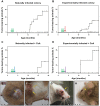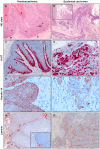Protective vaccination against papillomavirus-induced skin tumors under immunocompetent and immunosuppressive conditions: a preclinical study using a natural outbred animal model
- PMID: 24586150
- PMCID: PMC3930562
- DOI: 10.1371/journal.ppat.1003924
Protective vaccination against papillomavirus-induced skin tumors under immunocompetent and immunosuppressive conditions: a preclinical study using a natural outbred animal model
Abstract
Certain cutaneous human papillomaviruses (HPVs), which are ubiquitous and acquired early during childhood, can cause a variety of skin tumors and are likely involved in the development of non-melanoma skin cancer, especially in immunosuppressed patients. Hence, the burden of these clinical manifestations demands for a prophylactic approach. To evaluate whether protective efficacy of a vaccine is potentially translatable to patients, we used the rodent Mastomys coucha that is naturally infected with Mastomys natalensis papillomavirus (MnPV). This skin type papillomavirus induces not only benign skin tumours, such as papillomas and keratoacanthomas, but also squamous cell carcinomas, thereby allowing a straightforward read-out for successful vaccination in a small immunocompetent laboratory animal. Here, we examined the efficacy of a virus-like particle (VLP)-based vaccine on either previously or newly established infections. VLPs raise a strong and long-lasting neutralizing antibody response that confers protection even under systemic long-term cyclosporine A treatment. Remarkably, the vaccine completely prevents the appearance of benign as well as malignant skin tumors. Protection involves the maintenance of a low viral load in the skin by an antibody-dependent prevention of virus spread. Our results provide first evidence that VLPs elicit an effective immune response in the skin under immunocompetent and immunosuppressed conditions in an outbred animal model, irrespective of the infection status at the time of vaccination. These findings provide the basis for the clinical development of potent vaccination strategies against cutaneous HPV infections and HPV-induced tumors, especially in patients awaiting organ transplantation.
Conflict of interest statement
The authors have declared that no competing interests exist.
Figures







Similar articles
-
Expression of different L1 isoforms of Mastomys natalensis papillomavirus as mechanism to circumvent adaptive immunity.Elife. 2020 Aug 4;9:e57626. doi: 10.7554/eLife.57626. Elife. 2020. PMID: 32746966 Free PMC article.
-
Next generation L2-based HPV vaccines cross-protect against cutaneous papillomavirus infection and tumor development.Front Immunol. 2022 Oct 3;13:1010790. doi: 10.3389/fimmu.2022.1010790. eCollection 2022. Front Immunol. 2022. PMID: 36263027 Free PMC article.
-
Persistence of Mastomys natalensis papillomavirus in multiple organs identifies novel targets for infection.J Gen Virol. 2007 Oct;88(Pt 10):2670-2678. doi: 10.1099/vir.0.82955-0. J Gen Virol. 2007. PMID: 17872518
-
Developments in L2-based human papillomavirus (HPV) vaccines.Virus Res. 2017 Mar 2;231:166-175. doi: 10.1016/j.virusres.2016.11.020. Epub 2016 Nov 23. Virus Res. 2017. PMID: 27889616 Free PMC article. Review.
-
HPV vaccination for prevention of skin cancer.Hum Vaccin Immunother. 2015;11(2):353-7. doi: 10.4161/21645515.2014.983858. Hum Vaccin Immunother. 2015. PMID: 25692212 Free PMC article. Review.
Cited by
-
Establishment of an Immortalized Skin Keratinocyte Cell Line Derived from the Animal Model Mastomys coucha.PLoS One. 2016 Aug 17;11(8):e0161283. doi: 10.1371/journal.pone.0161283. eCollection 2016. PLoS One. 2016. PMID: 27533138 Free PMC article.
-
Expression of different L1 isoforms of Mastomys natalensis papillomavirus as mechanism to circumvent adaptive immunity.Elife. 2020 Aug 4;9:e57626. doi: 10.7554/eLife.57626. Elife. 2020. PMID: 32746966 Free PMC article.
-
Treatment and Prevention of HPV-Associated Skin Tumors by HPV Vaccination.Vaccines (Basel). 2024 Dec 20;12(12):1439. doi: 10.3390/vaccines12121439. Vaccines (Basel). 2024. PMID: 39772099 Free PMC article. Review.
-
Vaccination with human alphapapillomavirus-derived L2 multimer protects against human betapapillomavirus challenge, including in epidermodysplasia verruciformis model mice.Virology. 2022 Oct;575:63-73. doi: 10.1016/j.virol.2022.08.006. Epub 2022 Aug 23. Virology. 2022. PMID: 36070626 Free PMC article.
-
Care of Mastomys in the laboratory.Lab Anim (NY). 2016 May 20;45(6):219-24. doi: 10.1038/laban.1018. Lab Anim (NY). 2016. PMID: 27203263
References
-
- zur Hausen H (2002) Papillomaviruses and cancer: from basic studies to clinical application. Nat Rev Cancer 2: 342–350. - PubMed
-
- Schiller JT, Buck CB (2011) Cutaneous squamous cell carcinoma: a smoking gun but still no suspects. J Invest Dermatol 131: 1595–1596. - PubMed
-
- Akgül B, Cooke JC, Storey A (2006) HPV-associated skin disease. J Pathol 208: 165–175. - PubMed
Publication types
MeSH terms
Substances
LinkOut - more resources
Full Text Sources
Other Literature Sources
Medical
Molecular Biology Databases

